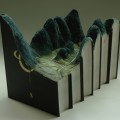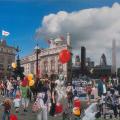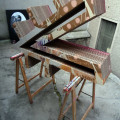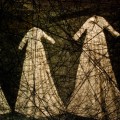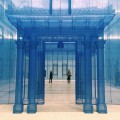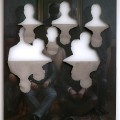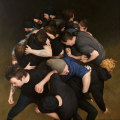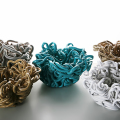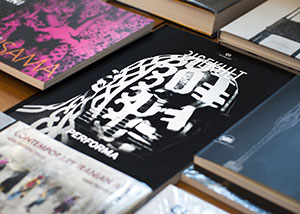I grew up in the 60s and 70s in the suburbs of London, and therefore also with the idea of a good life after the war. This was also happening in other countries, the widespread idea that you would have a car and other things. My other friends from Western Europe did not think so differently. But someone like me, who grew up in the suburbs, always carried a class identification that was very new. This includes, in my case, knowing that my father in order to make money for the family, had left school at the age of 15, and that his father was working at the age of 12 in a coal mine. Whoever moves in such circumstances, must decide early what he wants to do in this suburban, boring environment. So, I was active in the late seventies and early eighties in the anti-nuclear movement, because at that time we seemed so close to nuclear holocaust. A disaster seemed right at our doorstep shortly after a turbulent period of European history. The Americans and the Soviets were about to use Western Europe as a battlefield for their strategic nuclear war. It seemed that Europe would be sacrificed again. Through my participation in the movement, I came into contact with radical ideas, which one either accepts or rejects. For the opponents of nuclear weapons in Germany, Britain and elsewhere, were members of religious groups as well as anarchists. Both extremes thought they could use the situation for their own purposes. I myself had the desire to study, philosophy and law, to carry myself as someone with both practical and conceptual skills in order to revoke the social models of the late twentieth century. The aim was both to use a lot of energy and a lot of time to invest in those who fought for freedom and protect the labour movement from demonization. To act effectively against the demonizers, you have to be well formed. It was not enough to just be a punk. You would have to be just as glamorous as the powerful. Today we know that this way led to the apparent charms of Tony Blair and Bill Clinton. Who ultimately failed. This generation did not succeed in enforcing that for which they entered. In the early eighties, the situation was such that I did not trust myself. All summer long, in the services of a lawyer, I noticed how much the prevailing structures are, indeed so strong that I was not sure if I would be able to preserve my beliefs or my starting point. Against this backdrop it seemed to me that to study at an art school was the right thing to do, because it included the denial of an organized life. Interestingly it seemed to me that there you can do things without having to have cultural permission. For example, construct a building or write a book or organise a demonstration. You then could either do it all or nothing, and it would nevertheless be tolerated under the umbrella of art. This field I wanted to interrogate, and it appealed to me on the other side, as a class requirement, to be available for hire. In addition, I also had this sort of Irish or Celtic identification. The idea of the writer or artist in this case is always referred to as an active role. In Britain, one is suspicious of artists, however pragmatic, because they are associated with ideologies and revolutions. In cultures like Ireland that are struggling with their national identity, art and literature are both the amplifier and the identity of the critic. I was fascinated by how things are valued within the society. If someone said something had a fundamental property, or is better than something else, I did not believe it for one second. For it cannot have any without a whole array of cultural support behind it. It is always political. If someone acclaimed the great masterpieces by Titian, or whoever, I could never believe that such a verdict was possible without a certain set of cultural values. No work has an essential value in itself. There are no fundamental, eternal values inherent in things. If I rephrase it, it does not imply that you cannot recognise the difference between a good and a bad picture, and of course I also see the difference between an original and a great copy. But that does not change the fact that both the one and the other exist for a reason within the culture. Neither are things in a value-free environment, yet they are of a priori an essential value. To interfere with this code could be very productive. I am not one of those people who insist on the traditional route of an academic career. I read not only because I want to understand things, but also because I suffer a bit from a little inferiority complex. When I read “Mille Plateaux”, I started on page one tried to read it until the end. Nobody had ever told me that you do not have to read every book from beginning to end, so I was shocked that people do not read whole books. I spent extensive time with reading, but even months without any reading. In general, we believe artists might have a permanent mode of existence or a fixed method. If I cannot read or work, I develop an incredible sense of guilt. Then I feel I must do it, and I imagine that my artworks convey a repressed anxiety about the fact that there are things that need to be made or received. If you think your art is able to annoy the bourgeoisie, then you are greatly mistaken, bourgeois identity has changed. Meanwhile, it has internalized the conditions of contemporary art. As such artists are wasting their time if they imagine being able to pee on the bourgeoisie. With the great art struggles of the last fifteen years it does not matter whether an artist is better than someone or has demonstrated a better methodology than others. If you read certain magazines you do not see a struggle over what artists do, but about who articulates the critical voice. I think this is more subversive within the contextual framework of art. This does not exclude the possibility of an art form with a subversive potential. My best role is to keep a distance from the edge. There is an analogy to horror movies. It is a bit like when people in the forest are on a quest for a monstrous figure and suddenly realize it is right among them or worse it is one of them. If such a thing as subversion or resistance can function in art, it is in my desire to be in the middle, instead of looking for a speculative edge. Perhaps this paradox arises from a misunderstanding of Ludwig Wittgenstein. In order to go beyond the boundary of thought you would have to know where the boundary is. What interests me is the battle over the middle ground while laughing at the people who build boundaries in order to point them out to you. What will happen if you only hold up a mirror to the dominant culture of what they already know? Look at the way the British government is dealing with demonstrations. It is kettling them. Previously, the police would go on a melée, with protesters. Today, they block off all the streets and don’t allow you to go away from the demonstration. You are forced to demonstrate. In the end, you run out of energy. A very clever strategy and quite familiar in the art context. Anyway, today, an artist never acts in isolation, unless he or she is in a particular psychological state or has a unique worldview. If you are trying to articulate moral or ethical differences on a transparent level, it is often wrong or unproductive. For, ultimately, each artist works with his knowledge only about those who are around him or her. For me, the question of subversion in art is associated with certain philosophical moments in history. The Subversive is not an inherent quality of art in such a way that the avant garde has always been to be subversive. Art cannot be explained by its market values, its subversive power, or its impotence. I have no particularly pronounced connection to any culture. For me, class identification is stronger than allegiance to the land. Its as Judith Miller, the psychoanalyst writes in her book, “Peers and Siblings” where she shows that parents have limited influence over behavior compared to friends, brothers, sisters and the context. Politics is not a choice. You are a political entity, whether you like it or not. Either you say that your work describes a political moment – that there is an edge to the work. Or you are going to believe that each work is part of a larger matrix of ideas. My role within the context of art is to play a game with time and meaning, instead of using art as a straightforward tool. My method is extremely political – in the lobbying and strategy sense. Many things have been achieved since the democratization of art, which means that people can enter into this activity without an education or certain skills. But also the art of many artists could be described as deeply sentimental about ethical or honest practice. Work that can be identified with a real job or real failure. Roles formulated as the presented self, part of a parallel working class and the idea of the democratization of practice, enriched in the paradoxical, combined with a somewhat antidemocratic belief that there is no one better than them. There is no evidence that Donald Judd hoped to do in the future, anything other than what Donald Judd did. But Donald Judd also once wrote, art is diverse and it will be even more so. We are currently experiencing the glorious degradation of boundless subjectivity, and this is normal, essential and also a byproduct of the politics of identity, which compels us to understand more and more stories. This tension between difference and the collective interests me. The fact that we are obliged to recognize differences and that we carry simultaneously a sense of collectivity within us. How is it possible to be together and work together while being alone and different? This is a both a political and cultural concern. In this context, the concept of contemporary art might be on the verge of describing a historical era period that is ending. As it can be characterized by two extremes that are non-productive. An excessive super-subjectivity battling an almost pure documentary structure. Both of these things can no longer be subsumed under contemporary art.
|
|
|



























